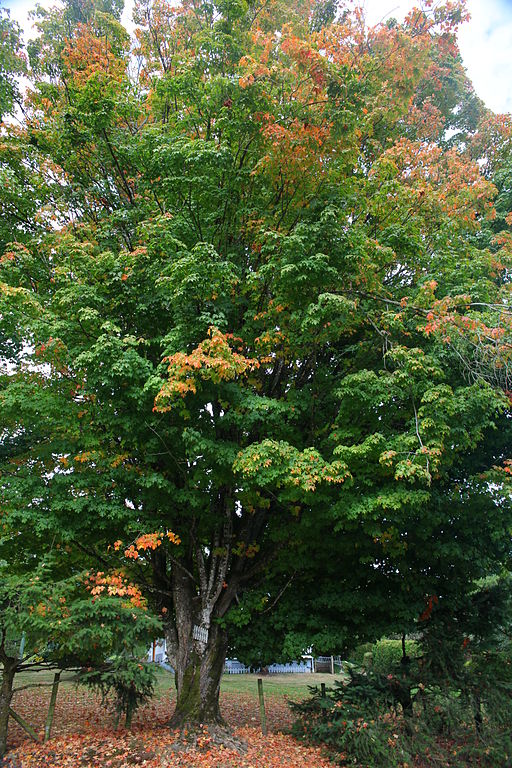Maple (Acer)
| Common Name | Maple |
| Latin Name | Acer (genus) |
| Icon(s) |   
 
|
|
Sugar Maple Tree.JPG | |
1. Description
Maples are deciduous trees, four of which are native to various regions within 'Souls. The bark of such trees changes with age -- smooth and pale is common in youth, darker cracks later occurring.
The distinctive fruit are called samaras, maple keys, whirlybirds, etc. These seeds occur in pairs, each containing one seed enclosed in a "nutlet" attached to a wing of fibrous, papery tissue.
2. Types
- The Silver Maple is closely related to the Red Maple, and can hybridise with it.
2.1 Red Maple (Acer rubrum)
Many of its features, especially its leaves, are quite variable in form. It is a medium to large sized tree, reaching heights of 18 to 27 metres (59 to 89 ft). Red maple seldom lives longer than 150 years, making it short to medium lived.
Growth
Common. Red maple is adaptable to a very wide range of site conditions; it can be found growing in swamps, on poor dry soils, and most anywhere in between. It is found throughout all territories of 'Souls. The tree is found most commonly along the tops of ridges, sandy or rocky upland and otherwise dry soils, as well as in nearly pure stands on moist soils and the edges of swamps.
Other
- Toxicity: Leaves, especially dead or wilted, are extremely toxic to horses. 700 grams (1.5 pounds) is lethal. Symptoms occur within 1-2 days after ingestion and can include depression, lethargy, increased rate and depth of breathing, increased heart rate, jaundice, dark brown urine, abd coma. Treatment was limited in the time of humanity: Luperci would find it impossible to treat.
- Syrup: As a soft maple, early budding imparts an undesirable flavor to the syrup. Red maple can only be tapped during a short season and is more rarely used for syrup.
2.2 Moose Maple (Acer pensylvanicum)
This small tree grows to 5–10 m tall, with a trunk up to 20 cm diameter. The young bark is striped with green and white, and when a little older, brown. They tend toward a pale yellow rather than the reds and oranges of other maples.
Growth
Very Common. They typically occur as understory trees in mountain forests, often along streamsides. Moosewood is an understory tree of cool, moist forests, often preferring slopes. It is among the most shade-tolerant of deciduous trees, capable of germinating and persisting for years as a small understory shrub, then growing rapidly to its full height when a gap opens up.
Other
- Wood: The wood is soft and considered undesirable among maples. Its shade tolerance makes it difficult to control, as it is often present in great numbers in the understory.
- Toxicity: The sap may cause a mild contact reaction.
2.3 Silver Maple (Acer saccharinium)
The silver maple is a relatively fast-growing deciduous tree, commonly reaching a height of 15–25 m (50–80 ft). The trunks tend to produce cavities, which can shelter squirrels, raccoons, opossums, owls and woodpeckers. It has brittle wood, and is commonly damaged in storms. The roots are shallow and fibrous.
Growth
Semi-Common. It is a highly adaptable tree, though it prefers strong sunlight and water -- it makes habitat beside streams, brooks, and lakes. It is found only in southern New Brunswick Saint Croix Highlands and Miramichi Wilderness areas.
Other
- Wood: Can be used to make baskets and furniture.
- Food and Medicine: Native Americans used the sap of wild trees to make sugar, as medicine, and in bread. It produces a sweet sap with a comparatively low sugar content.
2.4 Sugar Maple (Acer saccharum)
Sugar maple is best known for its bright fall foliage and for being the primary source of maple syrup. The fall color is often spectacular, ranging from bright yellow through orange to fluorescent red-orange. Sugar maples also have a tendency to color unevenly in fall. In some trees, all colors above can be seen at the same time.
Growth
Common. Pure stands are common (e.g., The Sugarwoods), though it is also associated with Ash and Red Oak. Sugar Maple is shade tolerant and can grow comfortably in any type of soil, except sand. Its salt tolerance is low and it therefore is never found along coastal areas.
Other
- Syrup: Produces a clear, sugary syryp -- considered the best syrup producer of Nova Scotia.
- Wood: The wood is one of the hardest and densest of the maples, and was prized for furniture and flooring. The sapwood may be white in color.
2.5 Mountain Maple (Acer spicatum)
This is a shrub (not a tree!) that makes up the undergrowth of the forests. It is very common and is found throughout 'Souls.
Uses
- Medicine: Indigenous peoples infused the piths of young twigs to produce treatments for eye irritation and made poultices from boiled root chips. It is also said to be used to relieve stress
3. Uses
3.1 Wood
- Maple is considered a tonewood and was used in numerous musical instruments. Maple is harder and has a brighter sound than Mahogany. Additionally, it was used for bowling pins, baseball bats, and butcher block tables prior to the apocalypse. Maple is used in as the core material in the limbs of a recurve bow in archery.
- Its grain can occur with patterning: flame, quilt, birdseye, or burled.
- Dried wood is often used for the smoking of food.
4. More
- Maple - Wikipedia, Wikipedia:Acer_saccharum, Wikipedia:Acer_rubrum, Wikipedia:Acer_pensylvanicum, Wikipedia:Acer_saccharinum, Wikipedia:Acer_spicatum
5. 'Souls
- In Casa di Cavalieri territory lies The Sugarwoods, which is filled with Sugar Maple trees
- Hey, did your character do something cool with this plant?
- Or maybe your pack has it for trade?

